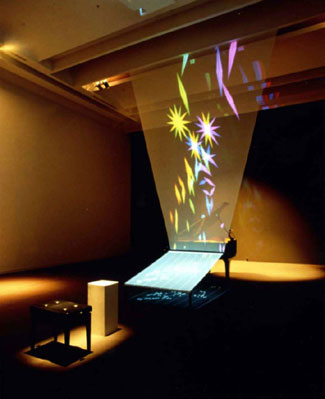Clavilux 2000 – Interactive instrument for generative music visualization from Jonas Heuer on Vimeo.
Think of playing musical notes for a moment, or close your eyes while fingering a piano keyboard. Odds are, some visual – however abstract – pops into your mind. Visualizing musical notes is second nature in the digital realm, once a note and an image can each be represented with numbers.
Clavilux 2000 by Jonas Friedemann Heuer is one of the latest works to run with the idea. As you play notes, beams of color drift up from the keyboard. In 3D mode, those beams take on a lovely, subtle quality. The model itself isn’t new, owing the notes-as-lines model to player pianos (or even music boxes), and recalling light organs. But there is something intuitive about this model – and I can imagine it being a terrific way to encourage someone to practice. (Well, that or else it could be distracting while practicing!)
Description. Thanks to Yifan Mai for the link; via infosthetics.com, a fantastic resource for exploring ways of visualizing information.
Clavilux 2000 is a music visualization installation that produces generative real-time animations of music. It consists of a computer running vvvv patch hooked up to a MIDI keyboard and projector. Every note played on the keyboard produces a stripe, whose proportions and color correspond to how the note was played. For instance, the color is mapped to the tonality of the note via the circle of fifths, thus visualizing harmonic consonance and dissonance. Besides looking really cool, it also thus creates unique “fingerprints” of each performance.
Clavilux 2000 is extremely close in design to a key 1995 work by media artist Toshio Iwai, known most recently for the Yamaha Tenori-On and Nintendo-published ElectroPlankton DS (each of which uses ideas from the earlier project). Piano–as image media and related works employed both inputs and outputs. (in the installation, visitors could use a trackball to enter note events visually on a screen; in performance with Ryuichi Sakamoto, the work used a piano. In each, events fly off perpendicular to the piano keyboard as beams of light, just as in the work here. That’s not a criticism, incidentally – even without seeing Iwai’s work, it’s a logical solution, because the keyboard organizes notes into an array of thin rectangles (the keys).
Unfortunately, Iwai’s work is not well-documented online; videos of these pieces have been removed. I do have a few resources for you, however. At bottom, there is a video of a 2006 Ars Electronica talk on the visual interface for music. (I have some video of Toshio’s similar thoughts around the launch of the Tenori-On which I should publish.) And for more:
Toshio Iwai talking about the visual-musical interface[artintelligence]
Toshio Iwai keynote at Futuresonic [pixelsumo]
http://www.nydigitalsalon.org/10/artwork.php?artwork=57
